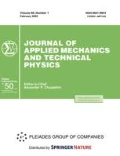Abstract
Relations for the principal values of the damage tensor based on data on the speeds of longitudinal and transverse waves are proposed. The relationship of acoustic anisotropy with the principal values of the damage tensor are established. The distributions of local speeds and damage along the thickness of the specimen are studied. It is shown that damage is localized in a narrow surface layer, with local damage maxima far exceeding the average damage value.
We’re sorry, something doesn't seem to be working properly.
Please try refreshing the page. If that doesn't work, please contact support so we can address the problem.
References
R. W. Benson and V. J. Raelson, “From Ultrasonics to a New Stress-Analysis Technique, Acoustoelasticity,” Product. Eng. 30 (29), 56–59 (1959).
D. S. Hughes and J. L. Kelly, “Second-Order Elastic Deformation of Solids,” Phys. Rev. 92 (5), 1145–1159 (1953).
N. E. Nikitina, Acoustoelasticity. Experience of Practical Application (Talam, Nizhniy Novgorod, 2005) [in Russian].
M. Hirao and Y. H. Pao, “Dependence of Acoustoelastic Birefringence on Plastic Strains in a Beam,” J. Acoust. Soc. Amer. 77 (5), 1659–1664 (1985).
M. Kobayashi, “Ultrasonic Nondestructive Evaluation of Microstructural Changes of Solid Materials under Plastic Deformation. 1. Theory,” Int. J. Plasticity 14 (6), 511–522 (1998).
A. K. Belyaev, A. M. Lobachyov, V. S. Modestov, et al., “Estimation of Plastic Strain Using Acoustic Anisotropy,” Izv. Ross. Akad. Nauk, Mekh. Tverd. Tela, No. 5, 124–131 (2016).
B. O’Neill and R. G. Maev, “Acousto-Elastic Measurement of the Fatigue Damage in Waspaloy,” Res. Nondestruct. Evaluat. 17 (3), 121–135 (2006).
V. I. Erofeev, A. N. Morozov, and E. A. Nikitina, “Accounting for the Effect of Material Damage on the Propagation Speed of an Elastic Wave in It,” Electron. Zh., Tr. Mosk. Aviats. Inst., No. 40, 1–5 (2010).
O. V. Muravieva, V. V. Muraviev, M. A. Gabbasova, et al., “Electromagnetic-Acoustic Structural Analysis of Rolled Bars,” AIP Conf. Proc. 1785 (1), 030017 (2016).
M. Fishkis and J. C. Lin, “Formation and Evolution of a Subsurface Layer in a Metal Working Process,” Wear 206, 156–170 (1997).
S. Ghosh, M. Li, and D. Gardiner, “A Computational and Experimental Study of Cold Rolling of Aluminum Alloys with Edge Cracking,” J. Manuf. Sci. Eng. 126, 74–82 (2004).
H. Riedel, F. Andrieux, and T. Walde, “The Formation of Edge Cracks during Rolling of Metal Sheet,” Steel Res. Int. 78, 818–824 (2007).
K. Kenmochi, I. Yarita, H. Abe, et al., “Effect of Micro-Defects on the Surface Brightness of Cold-Rolled Stainless-Steel Strip,” J. Mater. Process. Technol. 69, 106–111 (1997).
M. A. Golovnin and R. F. Iskhakov, “Formation of Properties of Aluminum Alloy in Hot Rolling,” in Materials Science and Metal Physics of Light Alloys, Proc. 3rd Int. Scientific Scholarship for Youth, Ekaterinburg, December 8–12, 2014 (Ural. Federal University, Ekaterinburg, 2014), pp. 208–210.
F. D. Murnaghan, “Finite Deformation of Elastic Solid,” Amer. J. Math. 59, 235–260. (1937).
A. I. Lur’e, Nonlinear Theory of Elasticity (Nauka, Moscow, 1980) [in Russian].
L. M. Kachanov, “On the Fracture Time in Creep,” Izv. Akad. Nauk SSSR, Otd. Tekh. Nauk, No. 8, pp. 26–31.
S. Murakami and N. Ohno, “A Continuum Theory of Creep and Creep Damage,” in Creep in Structures, Ed. by A. R. S. Ponter and D. R. Hayhurst (Springer, Berlin, 1981), pp. 422–443.
A. S. Semenov, “Symmetrization of the Effective Stress Tensor for Media with Anisotropic Damage,” Nauch.-Tekh. Vedom. St.-Peterb. Gos. Politekh. Univ., Fiz.-Mat. Nauiki 10 (2), 82–98 (2017).
A. K. Belyaev, A. I. Grishchenko, V. A. Polyanskiy, et al., “Acoustic Anisotropy and Dissolved Hydrogen as Indicators of Waves of Plastic Deformation,” in Days on Diffraction, Proc. of the Int. Conf., St. Petersburg, June 19–23, 2017, pp. 39–44.
Author information
Authors and Affiliations
Corresponding author
Additional information
Original Russian Text © A.S. Semenov, V.A. Polyanskii, L.V. Shtukin, D.A. Tretyakov.
Translated from Prikladnaya Mekhanika i Tekhnicheskaya Fizika, Vol. 59, No. 6, pp. 201–210, November–December, 2018.
Rights and permissions
About this article
Cite this article
Semenov, A.S., Polyanskii, V.A., Shtukin, L.V. et al. Effect of Surface Layer Damage on Acoustic Anisotropy. J Appl Mech Tech Phy 59, 1136–1144 (2018). https://doi.org/10.1134/S0021894418060202
Received:
Revised:
Published:
Issue Date:
DOI: https://doi.org/10.1134/S0021894418060202

